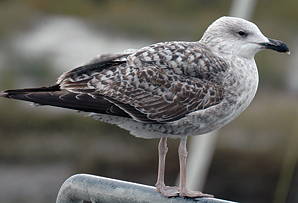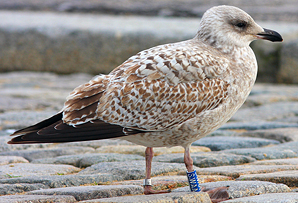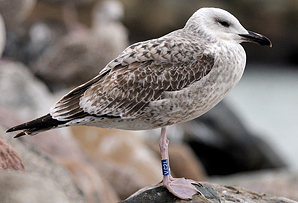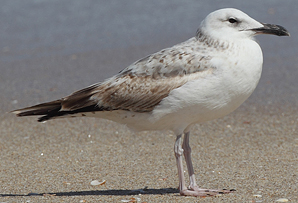 Larus cachinnans
Larus cachinnans
(last update:
Greg Neubauer
Marcin Przymencki
Albert de Jong
Mars Muusse
In 2010, Chris Gibbins, Brian J. Small and John Sweeney published two extensive papers in Britsih Birds, dealing with Caspian Gull. Below, you will find the content of the first paper "Part 1: typical birds".
First part: INTRODUCTION & IDENTIFICATION
Second part: JUVENILES (1CY birds in July–September)
Below, we continue with PART 3 "Birds in their first winter (1CY/2CY birds in October–April)". "we" in the text below refers to the original authors. If any errors occur in this text, please let me know and mail to marsmuusseatgmaildotcom.
Birds in their first winter (1CY/2CY birds in October–April)
At this age, cachinnans are arguably at their most striking and easy to identify (plates 59 & 60). The general impression is of a bird with an extremely white head and body, pale and rather delicately marked scapulars, and wing-coverts and tertials that, especially at a distance, look as though they have been painted softly in watercolours.
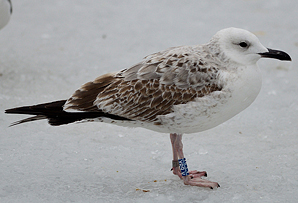 Larus cachinnans 1cy VP9Y December 12 2012, Damhus Sø -København, Denmark. Picture: Lars Krogh. Larus cachinnans 1cy VP9Y December 12 2012, Damhus Sø -København, Denmark. Picture: Lars Krogh. |
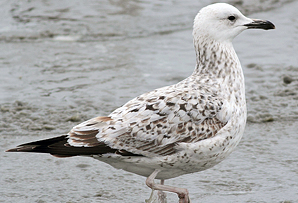 Larus cachinnans 2cy, 14 March 2012, Texel, the Netherlands. Picture: Herman Bouman. Larus cachinnans 2cy, 14 March 2012, Texel, the Netherlands. Picture: Herman Bouman. |
By October, cachinnans has second-generation mantle feathers, scapulars and, in some birds, coverts and tertials, representing the progression from juvenile to first-winter plumage. Second-generation scapulars may be highly distinctive, typically showing a silvery-grey ground colour (paler grey than those of adults) with a simple dark shaft streak and either a rather diffuse subterminal anchor pattern or a dark basal diamond; most lack strong crossbarring. The silvery ground colour fades rapidly as the winter progresses and the dark markings become more subdued, leading to an increasingly pale and uniform-looking bird. On many cachinnans, the lowest row of second-generation scapulars appear paler and more lightly marked than the rest, and hence form a pale band separating the upper scapulars from the brown wing-coverts. Younger feathers in a moult sequence may differ in pattern from older ones (Howell 2001), which may explain the presence of this pale band.
Typically, michahellis are quite different
(plate 61): their second-generation scapulars
are strongly marked with heavy crossbars and
a broad, dark anchor near the tip. The same
relative differences occur on any new wingcoverts
or tertials moulted in during the
autumn: cachinnans usually have simple and
subtle patterns, michahellis strong and bold
ones. The pattern on the second-generation
scapulars of Herring Gull is extremely variable
(plate 62) but in broad terms is intermediate
between that of cachinnans and
michahellis. The ground colour of each
feather ranges from pale, sandy brown to mid
brown, and most have darker crossbars and
an anchor pattern towards the tip. It is
extremely rare (perhaps unknown) for genetically
pure Herring Gulls to have the silver
tone and simple dark shaft streak of classic
cachinnans. Importantly, however, a significant
proportion of cachinnans have rather
heavily marked second-generation scapulars
(e.g. plate 63).
The striking appearance of many cachinnans during their first winter stems from a
combination of the patterns on new second-generation
feathers and wear on remaining
first-generation ones. Wear is especially
evident on birds reared earlier in more
southerly and easterly areas, where sun
bleaching and sand blasting (on dry beaches)
take their toll on feather condition. Even in
September, 1CY cachinnans around the Black
Sea can be rather worn and shabby. Light
'pencil' streaking on the head and body progressively
wears away, and can give rise to a
startlingly white appearance, compared with
Herring Gull. By midwinter, any remaining
streaks are confined to a neat necklace
around the lower rear neck. The white head
isolates and emphasises the dark eye. Wear
tends to simplify and thus emphasise the
pattern on remaining first-generation greater
coverts (dark base, pale distal bar) and, on
some, the second pale bar (on the lowest row
of median coverts) becomes prominent. The
fact that this second bar is less frequently
apparent on the same feathers in late summer
suggests that its prominence is related to
wear and fading.
By spring, most cachinnans look a little paler than in autumn, with a more subdued contrast between the whites, greys, browns and blacks. The first-generation feathers can look rather washed-out, with the feather patterning less clear. For those individuals that included some coverts or tertials in the post-juvenile moult, these (now somewhat worn) feathers show up as discontinuities on an otherwise juvenile wing (plate 60). On some, pure grey feathers are distributed randomly across the scapulars (these may be third-generation feathers grown during the winter), giving an overall impression quite unlike Herring Gull; in fact, such advanced cachinnans (and especially those which also have some second-generation coverts and tertials) are more likely to be mistaken for a second-winter Herring Gull than a first-winter. The plumage of michahellis also fades over the winter and those that have retained their first-generation coverts and tertials can be a trap for the unwary. Despite their original notched patterns, the worn coverts of michahellis can become surprisingly uniform by spring. Similarly, tertial wear makes the feather pattern more difficult to discern and so it is effectively inseparable from that of cachinnans. The rangy appearance of some michahellis means that observers faced with a worn, putative cachinnans in the late winter/early spring period should be wary. Careful assessments of bill shape, head proportions, call and details of the underwing are critical at this time.
During their first autumn and winter, a small proportion of michahellis moult their tail feathers (certainly less than 20%, and perhaps less than 10%; Hannu Koskinen and Visa Rauste pers. comm., based on studies in Italy and Greece respectively). Herring Gulls (many thousands observed) and cachinnans in northwest Europe (c. 100 first-winters observed) normally do not, unless rectrices are lost or damaged. Thus, a late winter/early spring 2CY is unlikely to be cachinnans if it has new tail feathers – it will most likely be michahellis. However, the wintering range of cachinnans is large and, for example, those wintering in the Persian Gulf may follow a different strategy; insufficient data are available to assess this.
As the remiges and rectrices are not (normally)
included in the post-juvenile moult of cachinnans, the wing and tail patterns of
first-winters are the same as described above
for juveniles. However, by late winter cachinnans tend to look paler in flight than in the
autumn (as a consequence of wear and
fading) and so the primary window or
Venetian-blind effect often appears more
contrasting. The underwing also looks paler,
more gleaming white and more sparsely
marked than earlier in the winter (plate 64).
This suggests that at least some underwing coverts
and axillaries are dropped or replaced
with pure white feathers over the winter.
Bare parts
The bill remains black with a variable amount of dirty pink on the basal portion. Close views may reveal a pale tip, which can suggest that birds have a diffuse, subterminal dark band. There is a tendency for cachinnans to have a more extensively pale bill than michahellis during the first winter, but this is far from diagnostic. The legs and irides are as described for juveniles.
END OF PART 3
CONTINUE AT PART 4: BIRDS IN THEIR FIRST SUMMER (2CY BIRDS IN MAY-SEPTEMBER)
 Larus cachinnans 1CY & 4CY UKK L-006940 September & October 2010, Denmark & March 2013, the Netherlands.
Larus cachinnans 1CY & 4CY UKK L-006940 September & October 2010, Denmark & March 2013, the Netherlands. 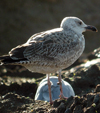 Larus cachinnans 1CY UKK L-002197 October 12-18 2007, Deponie Pohlsche Heide - Minden, Germany (52°23'05N, 08°46'45E).
Picture: Armin Deutsch.
Larus cachinnans 1CY UKK L-002197 October 12-18 2007, Deponie Pohlsche Heide - Minden, Germany (52°23'05N, 08°46'45E).
Picture: Armin Deutsch. Larus cachinnans 1CY HCL23 August 10 & October 10 2015, Kampen, the Netherlands & Kent, UK.
Picture: Cor Fikkert & Michael Southcott.
Larus cachinnans 1CY HCL23 August 10 & October 10 2015, Kampen, the Netherlands & Kent, UK.
Picture: Cor Fikkert & Michael Southcott.Ringed as pullus on May 20 2015 at Yavonov, Lviv Oblast, (westernmost) Ukraine.
 Larus cachinnans 1CY PACZ October - November 2009, Deponie Pohlsche Heide - Minden, Germany (52°23'05N, 08°46'45E).
Picture: Armin Deutsch.
Larus cachinnans 1CY PACZ October - November 2009, Deponie Pohlsche Heide - Minden, Germany (52°23'05N, 08°46'45E).
Picture: Armin Deutsch. Larus cachinnans 1CY & 3CY PANX August & October 2009, Deponie Pohlsche Heide - Minden, Germany & December 2012, Herstal - Liege, Belgium.
Larus cachinnans 1CY & 3CY PANX August & October 2009, Deponie Pohlsche Heide - Minden, Germany & December 2012, Herstal - Liege, Belgium.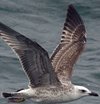 Larus cachinnans 1CY & 3CY PAPB October 30 2009, North Sea, the Netherlands & January 03 2011, Dartford, Great Britain.
Larus cachinnans 1CY & 3CY PAPB October 30 2009, North Sea, the Netherlands & January 03 2011, Dartford, Great Britain. 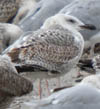 Larus cachinnans 1CY & 3CY PAUS October 12 2009 & December 2011, Sweden & Poland. Picture: Mats Rellmar & Michal Polakowski.
Larus cachinnans 1CY & 3CY PAUS October 12 2009 & December 2011, Sweden & Poland. Picture: Mats Rellmar & Michal Polakowski. Larus cachinnans 1CY PCDP October 24 2011, Jaroslawiec, Poland. Picture: Michal Polakowski.
Larus cachinnans 1CY PCDP October 24 2011, Jaroslawiec, Poland. Picture: Michal Polakowski.  Larus cachinnans 1CY PDDK October 03 2010, Wörth, Austria. Picture: Wolfgang Schweighofer.
Larus cachinnans 1CY PDDK October 03 2010, Wörth, Austria. Picture: Wolfgang Schweighofer. Larus cachinnans 1CY PDHN October 19 2010, Den Haag, the Netherlands. Picture: Frank van der Meer.
Larus cachinnans 1CY PDHN October 19 2010, Den Haag, the Netherlands. Picture: Frank van der Meer.  Larus cachinnans 1CY-2CY PHHS October 2011 & March 2012, the Netherlands. Picture: Vincent van der Spek & O.J. Goreng.
Larus cachinnans 1CY-2CY PHHS October 2011 & March 2012, the Netherlands. Picture: Vincent van der Spek & O.J. Goreng.  Larus cachinnans 1CY PHPP October 07 2011, Katy Rybackie, Poland. Picture: Michal Polakowski.
Larus cachinnans 1CY PHPP October 07 2011, Katy Rybackie, Poland. Picture: Michal Polakowski.  Larus cachinnans 1CY-2CY PKND October, November, December 2012 & March 2013, Deponie Pohlsche Heide - Minden, Germany (52°23'05N, 08°46'45E).
Picture: Armin Deutsch.
Larus cachinnans 1CY-2CY PKND October, November, December 2012 & March 2013, Deponie Pohlsche Heide - Minden, Germany (52°23'05N, 08°46'45E).
Picture: Armin Deutsch. Larus cachinnans 1CY-2CY PKSD August 2012 - June 2013, Minden & Dümmer, Germany.
Picture: Armin Deutsch.
Larus cachinnans 1CY-2CY PKSD August 2012 - June 2013, Minden & Dümmer, Germany.
Picture: Armin Deutsch. Larus cachinnans 1CY PKXX October & December 2012, France. Picture: Alain Fossé & Patrick Derrien.
Larus cachinnans 1CY PKXX October & December 2012, France. Picture: Alain Fossé & Patrick Derrien.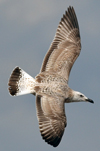 Larus cachinnans 1CY PKZU September 12 - October 04 2012, Deponie Pohlsche Heide - Minden, Germany (52°23'05N, 08°46'45E).
Picture: Armin Deutsch.
Larus cachinnans 1CY PKZU September 12 - October 04 2012, Deponie Pohlsche Heide - Minden, Germany (52°23'05N, 08°46'45E).
Picture: Armin Deutsch.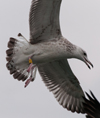 Larus cachinnans 1CY-2CY PLVE December 2012, February & October 2013, the Netherlands.
Larus cachinnans 1CY-2CY PLVE December 2012, February & October 2013, the Netherlands.  Larus cachinnans 1CY PSCZ October 17 2011, Krynica Morska, Poland. Picture: Artur Niemczyk.
Larus cachinnans 1CY PSCZ October 17 2011, Krynica Morska, Poland. Picture: Artur Niemczyk. 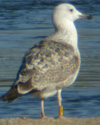 Larus cachinnans 1CY PUDB October 17 2010, Lubna, Poland. Picture: Michal Rycak.
Larus cachinnans 1CY PUDB October 17 2010, Lubna, Poland. Picture: Michal Rycak. 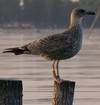 Larus cachinnans 1CY & 3CY PUHP 2010 & 2012, Miedwie lake, Poland, Simrishamn, Sweden & Friedrichshafen, Germany.
Larus cachinnans 1CY & 3CY PUHP 2010 & 2012, Miedwie lake, Poland, Simrishamn, Sweden & Friedrichshafen, Germany. 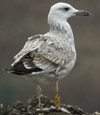 Larus cachinnans 1CY PUTA October 28 2010, Lubna, Poland. Picture: Michal Rycak.
Larus cachinnans 1CY PUTA October 28 2010, Lubna, Poland. Picture: Michal Rycak.  Larus cachinnans 1cy PUSZ October 07-08 2010, Rødvig-Stevns, Sjælland, Denmark. Picture: Lars Krogh.
Larus cachinnans 1cy PUSZ October 07-08 2010, Rødvig-Stevns, Sjælland, Denmark. Picture: Lars Krogh.  Larus cachinnans x michahellis hybrid 8P02 1CY, October 20 2005, Goczalkowice Reservoir, S Poland.
Picture: Robert Zbronski.
Larus cachinnans x michahellis hybrid 8P02 1CY, October 20 2005, Goczalkowice Reservoir, S Poland.
Picture: Robert Zbronski. Larus cachinnans hybrid 1CY-2CY 74P1 October 2006 & March 2007, Poland & Germany. Picture: Zbigniew Kajzer & Armin Deutsch.
Larus cachinnans hybrid 1CY-2CY 74P1 October 2006 & March 2007, Poland & Germany. Picture: Zbigniew Kajzer & Armin Deutsch. Larus cachinnans 2CY 234P October 18 2007, Deponie Pohlsche Heide - Minden, Germany (52°23'05N, 08°46'45E).
Picture: Armin Deutsch.
Larus cachinnans 2CY 234P October 18 2007, Deponie Pohlsche Heide - Minden, Germany (52°23'05N, 08°46'45E).
Picture: Armin Deutsch. Larus cachinnans 1CY 452P October 28 2008, Deponie Pohlsche Heide - Minden, Germany (52°23'05N, 08°46'45E).
Picture: Armin Deutsch.
Larus cachinnans 1CY 452P October 28 2008, Deponie Pohlsche Heide - Minden, Germany (52°23'05N, 08°46'45E).
Picture: Armin Deutsch.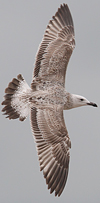 Larus cachinnans 1CY-2CY 01P4 October 2014 & November 2015, UK & Switzerland. Picture: Michael Southcott & Laridoprout.
Larus cachinnans 1CY-2CY 01P4 October 2014 & November 2015, UK & Switzerland. Picture: Michael Southcott & Laridoprout. Larus cachinnans 1CY 20P2 October 09 2014, Boulogne-sur-Mer, France. Picture: Jean-Michel Sauvage.
Larus cachinnans 1CY 20P2 October 09 2014, Boulogne-sur-Mer, France. Picture: Jean-Michel Sauvage.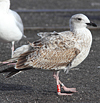 Larus cachinnans 1CY 29P4 October 09 2014, Boulogne-sur-Mer, France. Picture: Jean-Michel Sauvage.
Larus cachinnans 1CY 29P4 October 09 2014, Boulogne-sur-Mer, France. Picture: Jean-Michel Sauvage. Larus cachinnans 68P6 1CY, October 25 2015, Rødvig Harbor, Stevns, Denmark. Picture: Tonny Papillon.
Larus cachinnans 68P6 1CY, October 25 2015, Rødvig Harbor, Stevns, Denmark. Picture: Tonny Papillon. Larus cachinnans 1CY 1P00 October 2013 & April 2014, The Netherlands. Photo: Fred Visscher & Capser Groenewegen.
Larus cachinnans 1CY 1P00 October 2013 & April 2014, The Netherlands. Photo: Fred Visscher & Capser Groenewegen. Larus cachinnans 1CY-2CY PLG DN-27948 September 2011 - November 2012, Deponie Pohlsche Heide - Minden, Germany (52°23'05N, 08°46'45E).
Picture: Armin Deutsch.
Larus cachinnans 1CY-2CY PLG DN-27948 September 2011 - November 2012, Deponie Pohlsche Heide - Minden, Germany (52°23'05N, 08°46'45E).
Picture: Armin Deutsch. Larus cachinnans hybrid 1cy PLG DN-25914 October 01 2009, Westkapelle, the Netherlands. Picture: Theo Muusse & Ies Meulmeester.
Larus cachinnans hybrid 1cy PLG DN-25914 October 01 2009, Westkapelle, the Netherlands. Picture: Theo Muusse & Ies Meulmeester. Larus cachinnans 1CY-2CY PLG DN-25866 2008 & 2009, Deponie Pohlsche Heide - Minden, Germany (52°23'05N, 08°46'45E).
Picture: Armin Deutsch.
Larus cachinnans 1CY-2CY PLG DN-25866 2008 & 2009, Deponie Pohlsche Heide - Minden, Germany (52°23'05N, 08°46'45E).
Picture: Armin Deutsch.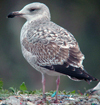 Larus cachinnans hybrid? 1CY PLG DN-25547 October 22 2009, Deponie Pohlsche Heide - Minden, Germany (52°23'05N, 08°46'45E).
Picture: Armin Deutsch.
Larus cachinnans hybrid? 1CY PLG DN-25547 October 22 2009, Deponie Pohlsche Heide - Minden, Germany (52°23'05N, 08°46'45E).
Picture: Armin Deutsch.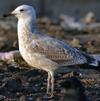 Larus cachinnans 1CY PLG DN-25430 August - October 2011, Deponie Pohlsche Heide - Minden, Germany (52°23'05N, 08°46'45E).
Picture: Armin Deutsch.
Larus cachinnans 1CY PLG DN-25430 August - October 2011, Deponie Pohlsche Heide - Minden, Germany (52°23'05N, 08°46'45E).
Picture: Armin Deutsch. Larus cachinnans hybrid 1CY PLG DN-21230 September - December 2007, Deponie Pohlsche Heide - Minden, Germany (52°23'05N, 08°46'45E).
Picture: Armin Deutsch.
Larus cachinnans hybrid 1CY PLG DN-21230 September - December 2007, Deponie Pohlsche Heide - Minden, Germany (52°23'05N, 08°46'45E).
Picture: Armin Deutsch.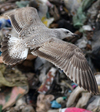 Larus cachinnans hybrid 1CY PLG DN-2xx2x October 23 2012, Deponie Pohlsche Heide - Minden, Germany (52°23'05N, 08°46'45E).
Picture: Armin Deutsch.
Larus cachinnans hybrid 1CY PLG DN-2xx2x October 23 2012, Deponie Pohlsche Heide - Minden, Germany (52°23'05N, 08°46'45E).
Picture: Armin Deutsch. Larus cachinnans 1CY E177 October 27 2013, Zagreb, Croatia (45°45'50"N 16°01'30"E). Picture Luka Jurinović.
Larus cachinnans 1CY E177 October 27 2013, Zagreb, Croatia (45°45'50"N 16°01'30"E). Picture Luka Jurinović. 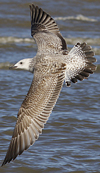 Larus cachinnans hybrid X007 1CY, October 05 2016, Katwijk, the Netherlands. Picture: Mars Muusse.
Larus cachinnans hybrid X007 1CY, October 05 2016, Katwijk, the Netherlands. Picture: Mars Muusse.  Larus cachinnans 1cy-2cy YH0T October 22 2011 - February 22 2012, United Kingdom, France & the Netherlands.
Larus cachinnans 1cy-2cy YH0T October 22 2011 - February 22 2012, United Kingdom, France & the Netherlands.  Larus cachinnans 1cy, October 22 2009, Westkapelle, the Netherlands. Picture: Ies Meulmeester.
Larus cachinnans 1cy, October 22 2009, Westkapelle, the Netherlands. Picture: Ies Meulmeester.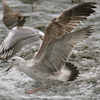 Larus cachinnans 1cy, October 25 2009, Westkapelle, the Netherlands. Picture: Ies Meulmeester.
Larus cachinnans 1cy, October 25 2009, Westkapelle, the Netherlands. Picture: Ies Meulmeester. Larus cachinnans 1cy, October 01 2009, Westkapelle, the Netherlands. Picture: Ies Meulmeester.
Larus cachinnans 1cy, October 01 2009, Westkapelle, the Netherlands. Picture: Ies Meulmeester. Larus cachinnans 1cy, October 21 2015, Boulogne-sur-Mer, France. Picture: Jean-Michel Sauvage.
Larus cachinnans 1cy, October 21 2015, Boulogne-sur-Mer, France. Picture: Jean-Michel Sauvage. Larus cachinnans 1cy, October 11 2008, Westkapelle, the Netherlands. Picture: Ies Meulmeester.
Larus cachinnans 1cy, October 11 2008, Westkapelle, the Netherlands. Picture: Ies Meulmeester. Larus cachinnans 1cy, October 25 2011, Westkapelle, the Netherlands. Picture: Ies Meulmeester.
Larus cachinnans 1cy, October 25 2011, Westkapelle, the Netherlands. Picture: Ies Meulmeester. Larus cachinnans 1CY, October 08 2006, Rødby Havn, Denmark. Picture: Lars Adler Krogh.
Larus cachinnans 1CY, October 08 2006, Rødby Havn, Denmark. Picture: Lars Adler Krogh.  Larus cachinnans 1CY, October 19 2010, Bøgeskov Havn, Stevns, Denmark. Picture: Birger Lønning.
Larus cachinnans 1CY, October 19 2010, Bøgeskov Havn, Stevns, Denmark. Picture: Birger Lønning. 
